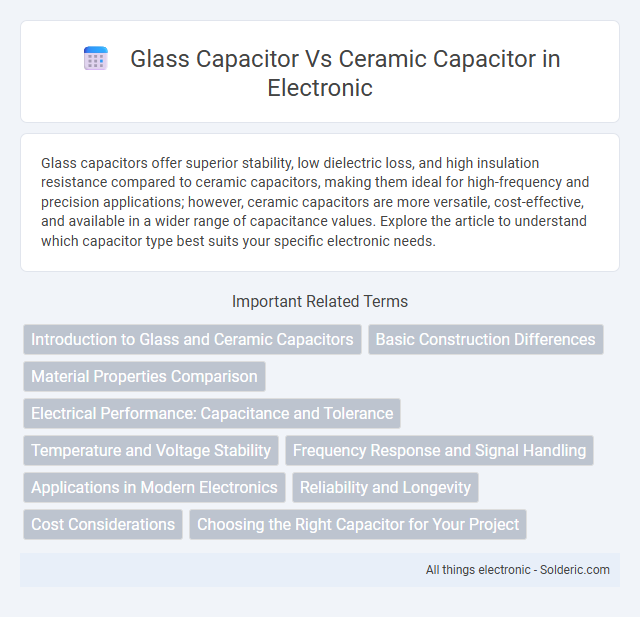Glass capacitors offer superior stability, low dielectric loss, and high insulation resistance compared to ceramic capacitors, making them ideal for high-frequency and precision applications; however, ceramic capacitors are more versatile, cost-effective, and available in a wider range of capacitance values. Explore the article to understand which capacitor type best suits your specific electronic needs.
Comparison Table
| Feature | Glass Capacitor | Ceramic Capacitor |
|---|---|---|
| Dielectric Material | Glass | Ceramic |
| Temperature Stability | Excellent (up to 400degC) | Good to Excellent (varies by type) |
| Capacitance Range | Low to Medium (pF to nF) | Wide (pF to uF) |
| Dielectric Loss | Very Low | Low to Moderate |
| Voltage Rating | High (up to several kV) | Medium to High (depending on type) |
| Size | Generally larger | Compact, small size |
| Frequency Response | Excellent at high frequencies | Good, varies by type |
| Cost | Higher | Lower |
| Application | Precision circuits, high voltage, high temperature environments | General purpose, decoupling, filtering |
Introduction to Glass and Ceramic Capacitors
Glass capacitors offer exceptional stability and low loss at high frequencies due to their hermetically sealed, rigid dielectric structure, making them ideal for precision applications. Ceramic capacitors provide versatile performance with a wide range of capacitance values and are commonly used in general-purpose electronic circuits due to their affordability and compact size. Understanding these fundamental differences helps you select the capacitor type best suited for your electronic design requirements.
Basic Construction Differences
Glass capacitors feature a dielectric made from high-purity glass, providing excellent stability and low loss, while ceramic capacitors use a ceramic material as the dielectric, offering high capacitance in a compact size but with varying temperature characteristics. The rigid glass dielectric ensures superior insulation and minimal aging effects, contrasting with the multilayer structure of ceramic capacitors that consist of alternating layers of ceramic and metal electrodes. Your choice depends on the application's need for stability, frequency response, and thermal tolerance.
Material Properties Comparison
Glass capacitors exhibit exceptional thermal stability and low dielectric loss due to their high-purity glass dielectric material, making them ideal for high-frequency and precision applications. Ceramic capacitors, made from various ceramic materials, offer a wide range of capacitance values with good reliability but typically have higher dielectric losses and temperature coefficients. Your choice between these capacitors should consider the operating environment and performance requirements, as glass capacitors provide superior stability while ceramic capacitors offer cost-effective versatility.
Electrical Performance: Capacitance and Tolerance
Glass capacitors offer superior electrical performance with extremely stable capacitance values and tight tolerance levels, typically around +-0.25% to +-1%. Ceramic capacitors, while widely used for their cost-effectiveness, usually exhibit wider tolerance ranges from +-5% to +-20%, and their capacitance can vary significantly with temperature and voltage changes. The superior dielectric properties of glass capacitors result in minimal capacitance drift, making them ideal for precision applications requiring high stability and reliability.
Temperature and Voltage Stability
Glass capacitors exhibit superior temperature and voltage stability compared to ceramic capacitors, maintaining consistent capacitance across wide temperature ranges and high voltage applications. Ceramic capacitors, especially Class II and III types, tend to experience capacitance variation with temperature changes and voltage stress, which can affect circuit performance. For applications requiring high precision and reliability under fluctuating environmental conditions, your choice of glass capacitors ensures minimal capacitance drift and enhanced durability.
Frequency Response and Signal Handling
Glass capacitors exhibit superior frequency response due to their minimal dielectric losses and stable capacitance over a wide frequency range, making them ideal for high-frequency and precision applications. In contrast, ceramic capacitors can suffer from higher equivalent series resistance (ESR) and microphonic effects, which may degrade signal integrity in sensitive circuits. Your choice will depend on the need for exceptional signal handling and low distortion at elevated frequencies, where glass capacitors often provide a performance advantage.
Applications in Modern Electronics
Glass capacitors offer superior stability and low dielectric loss, making them ideal for precision RF circuits and high-frequency applications in modern electronics. Ceramic capacitors provide cost-effective solutions with high capacitance values, frequently used in decoupling, filtering, and power supply smoothing in consumer devices. Both capacitor types are integral for optimizing performance and reliability across a wide range of telecommunications, automotive, and medical electronic systems.
Reliability and Longevity
Glass capacitors offer superior reliability and longevity due to their hermetic sealing, which prevents moisture ingress and maintains stable electrical properties over time. Ceramic capacitors, while cost-effective and widely used, can suffer from aging effects such as capacitance drift and microcracking under mechanical stress. Choosing a glass capacitor ensures your circuits experience minimal degradation and extended operational life in demanding environments.
Cost Considerations
Glass capacitors typically cost more than ceramic capacitors due to their superior stability and reliability in high-frequency applications. Ceramic capacitors offer a more economical solution for general-purpose circuits, making them ideal for cost-sensitive projects. Your choice depends on balancing performance requirements with budget constraints, as ceramic capacitors provide affordability while glass capacitors ensure long-term precision.
Choosing the Right Capacitor for Your Project
Glass capacitors offer superior stability, low loss, and high insulation resistance, making them ideal for precision applications where temperature and frequency stability are critical. Ceramic capacitors provide cost-effective solutions with a wide range of capacitance values and excellent high-frequency performance, suitable for general-purpose and decoupling uses. Your choice depends on the project's requirements for tolerance, durability, and environmental resistance, ensuring optimal circuit performance.
glass capacitor vs ceramic capacitor Infographic

 solderic.com
solderic.com